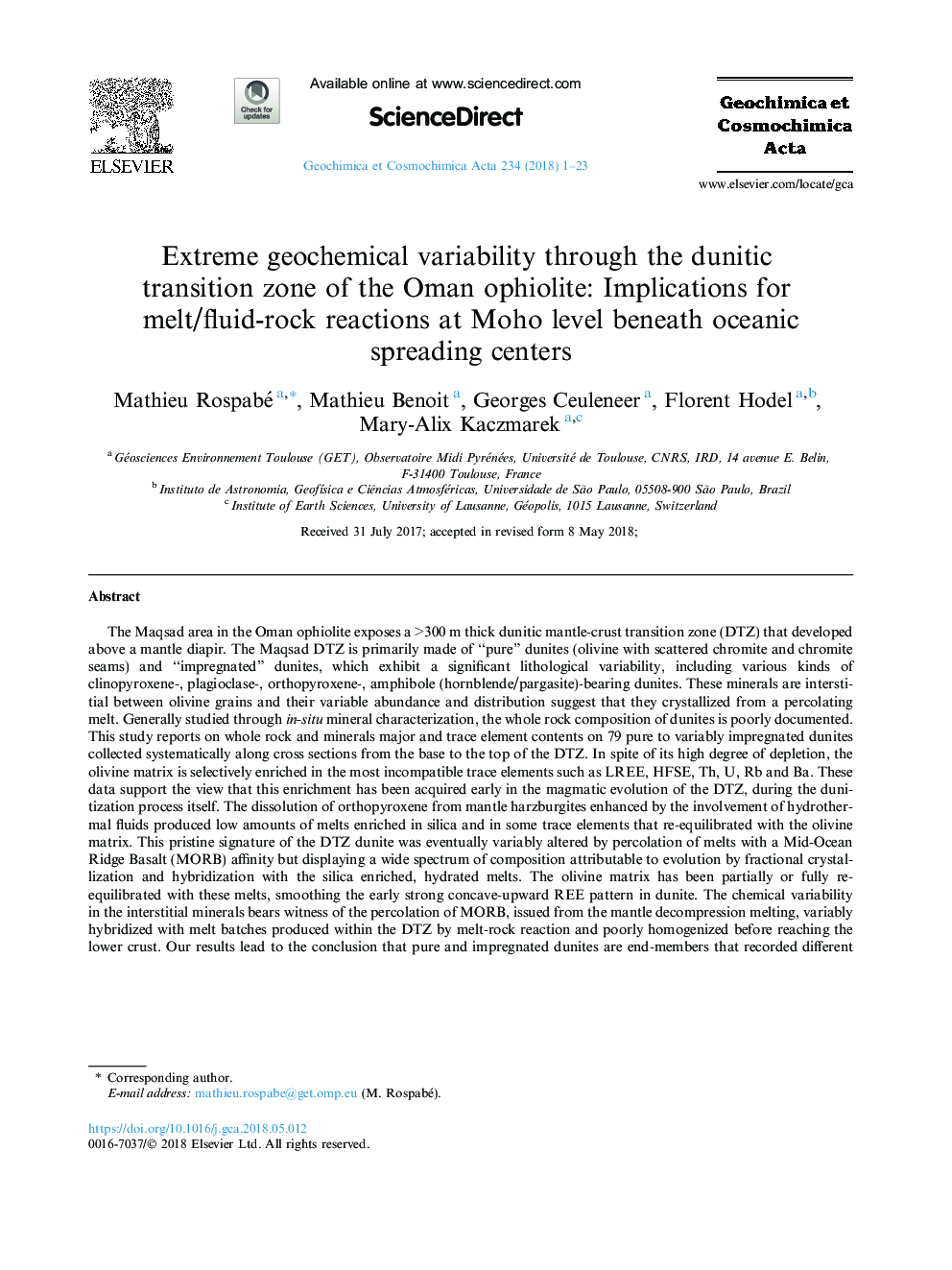| کد مقاله | کد نشریه | سال انتشار | مقاله انگلیسی | نسخه تمام متن |
|---|---|---|---|---|
| 8910697 | 1637923 | 2018 | 23 صفحه PDF | دانلود رایگان |
عنوان انگلیسی مقاله ISI
Extreme geochemical variability through the dunitic transition zone of the Oman ophiolite: Implications for melt/fluid-rock reactions at Moho level beneath oceanic spreading centers
دانلود مقاله + سفارش ترجمه
دانلود مقاله ISI انگلیسی
رایگان برای ایرانیان
کلمات کلیدی
موضوعات مرتبط
مهندسی و علوم پایه
علوم زمین و سیارات
ژئوشیمی و پترولوژی
پیش نمایش صفحه اول مقاله

چکیده انگلیسی
The Maqsad area in the Oman ophiolite exposes a >300â¯m thick dunitic mantle-crust transition zone (DTZ) that developed above a mantle diapir. The Maqsad DTZ is primarily made of “pure” dunites (olivine with scattered chromite and chromite seams) and “impregnated” dunites, which exhibit a significant lithological variability, including various kinds of clinopyroxene-, plagioclase-, orthopyroxene-, amphibole (hornblende/pargasite)-bearing dunites. These minerals are interstitial between olivine grains and their variable abundance and distribution suggest that they crystallized from a percolating melt. Generally studied through in-situ mineral characterization, the whole rock composition of dunites is poorly documented. This study reports on whole rock and minerals major and trace element contents on 79 pure to variably impregnated dunites collected systematically along cross sections from the base to the top of the DTZ. In spite of its high degree of depletion, the olivine matrix is selectively enriched in the most incompatible trace elements such as LREE, HFSE, Th, U, Rb and Ba. These data support the view that this enrichment has been acquired early in the magmatic evolution of the DTZ, during the dunitization process itself. The dissolution of orthopyroxene from mantle harzburgites enhanced by the involvement of hydrothermal fluids produced low amounts of melts enriched in silica and in some trace elements that re-equilibrated with the olivine matrix. This pristine signature of the DTZ dunite was eventually variably altered by percolation of melts with a Mid-Ocean Ridge Basalt (MORB) affinity but displaying a wide spectrum of composition attributable to evolution by fractional crystallization and hybridization with the silica enriched, hydrated melts. The olivine matrix has been partially or fully re-equilibrated with these melts, smoothing the early strong concave-upward REE pattern in dunite. The chemical variability in the interstitial minerals bears witness of the percolation of MORB, issued from the mantle decompression melting, variably hybridized with melt batches produced within the DTZ by melt-rock reaction and poorly homogenized before reaching the lower crust. Our results lead to the conclusion that pure and impregnated dunites are end-members that recorded different stages of the same initial igneous processes: pure dunites are residues left after extraction of a percolating melt while impregnated dunites correspond to a stage frozen before complete melt extraction. Therefore dunites trace elements contents allow deciphering the multi-stage processes that led to their formation at the mantle-crust transition zone.
ناشر
Database: Elsevier - ScienceDirect (ساینس دایرکت)
Journal: Geochimica et Cosmochimica Acta - Volume 234, 1 August 2018, Pages 1-23
Journal: Geochimica et Cosmochimica Acta - Volume 234, 1 August 2018, Pages 1-23
نویسندگان
Mathieu Rospabé, Mathieu Benoit, Georges Ceuleneer, Florent Hodel, Mary-Alix Kaczmarek,